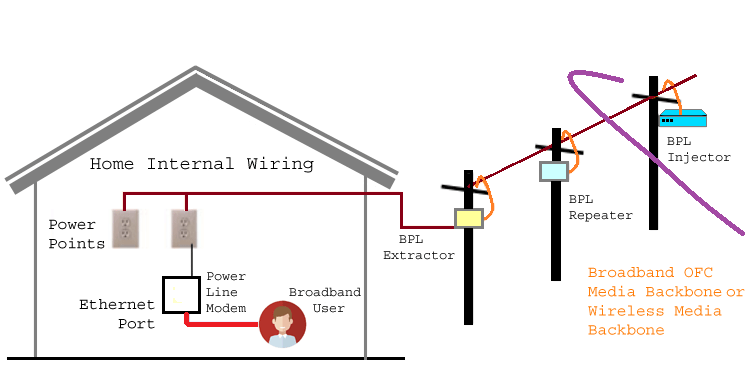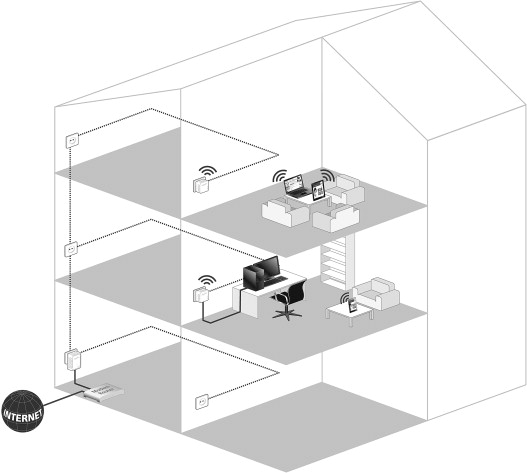
Power line Communications (PLC), also known as Power Line Telecommunications (PLT) is the communication technology which uses the existing public and private wiring for the transmission of the signals. Using PLC communication signals, high-speed data, voice and video are transmitted over low-voltage power lines.
PLC is a technology which has been in use since years but came now in more demand after the launch of new communication technologies which are being supported by PLC i.e. PLC would be a reliable communication medium for applications like Internet-of-things (IoT) and Smart Grids.
What is Power Line Communication?
The method of transferring power and data for communication through the same existing network of wires from one end to the other end is said as Power Line Communication. It provides broadband data communications on conductors which are already in use for the transmission of electric power using a modular signal. Now, this can be done through the home or premises wiring and may also be done through the existing electric power distribution system.
BPL (Broadband over Power Line) is also known as power-line Internet which supports PLC technology to allow Internet access through the transmission lines. The BPL technology with PLC is often used in remote locations where there is low amount of Internet access by cable or PDSL connections.
Types of Power Line Communication (PLC)
Basically, there are four types of PLC:
- In-house networking: High-speed data transmission can be provided for home networking using the In-House mains power wiring.
- Broadband over Power Line: Broadband internet access can be offered through the outdoor mains power wiring.
- Narrowband in-house applications: Low bit rate data services like home automation and intercoms can be controlled and used for communication through the In-house power mains.
- Narrowband outdoor applications: Narrowband outdoor applications can be used for automatic meter reading and remote surveillance or control.
How does PLC Work?
Like any other communication technology PLC also consists of a sender who modulates the data that is to be sent through a communication medium, and then the receiver will demodulate the data for further use. Apart from sending the signals for communication, PLC also allows the user to control and monitor all the connected devices to the power line because it is implemented in the same wiring system.

PLC sends a less fluctuating output compared to the old system. As you can see the diagram above, in the old system which had a rectifier and frequency generator for getting as stable as possible output of desired frequency but there was a small fluctuation in the output whereas the PLC system uses a Rectifier with a Filter & a Microcontroller which provides a stable & desired value output with the help of relay switch. As a result, the transmission of data is more accurate & more stable with good output signals.

Modulation Schemes used in PLC:
The modulation schemes used in PLC are Orthogonal Frequency Division Multiplexing (OFDM), Binary Phase Shift Keying (BPSK), Frequency Shift Keying (FSK), Spread-FSK (S-FSK) and proprietary schemes too (like the Differential Code Shift Keying (DCSK)).
OFDM provides high data rates but requires good computational horsepower for Fast Fourier Transforms (FFT) and Inverse-FFT (IFFT) output. While, on the other hand, BPSK, FSK are quite standard and simple modulation schemes that can be used in PLC but they offer low data rates. So, the currently running modulation scheme for PLC is OFDM with PSK modulation that can handle such a heavy computation.
Uses of PLC
The PLC is used for transmitting radio programs, utility company control switching mechanisms, transmission line protection, and automatic meter reading. Apart from that, there are also some automotive uses where the data, voice, and music are sent over direct current (DC) battery power line with some special filters to remove the line noise from the final output.
The term Power Line Communication (PLC) is known with a various name like as power line carrier, power-line digital subscriber line (PDSL), power line telecom (PLT), power line networking (PLN), mains communication, and broadband over power lines (BPL).
Advantages and Disadvantages of PLC
Advantages:
- Low Implementation Cost: PLC does not require any installation of new wires which as a result, would significantly reduce the deployment costs.
- Large Reach: PLC can enable communication with hard-to-reach nodes where the RF wireless signal suffers from high levels of attenuation like in the underground structures or the buildings with obstructions and metal walls, or simply wherever the wireless signal is undesirable due to the EMI issues in places like hospitals.

- Lower Running Cost: PLC provides a low-cost solution compared to the other existing technologies such as RF wireless or visible light communication (VLC) systems.
- Indoor High Speed: The implementation of PLC & VLC technologies integrated together has recently received a considerable amount of research attention, which resulted in the enabling of a new generation of high-speed indoor communications for numerous applications.
These advantages lead to more implementations of PLC networks in various industries. But with advantages there also comes some disadvantages.
Disadvantages
It also has some disadvantages such as:
- Low transmission speed,
- Sensitivity to disturbance,
- Nonlinear distortion and Cross-modulation between channels,
- Large size and
- The high price of capacitors and inductors used in the PLC system.
Due to these disadvantages, PLC is still not preferred in some applications.
Applications of PLC

PLC is widely used in technologies like Smart Grid and micro-inverters. Getting the technologies familiar with more number of users, soon PLC will have more adaptation for applications like lighting applications (for traffic light control, LED dimming etc.), industrial applications (for irrigation control etc.), machine-to-machine applications (like for vending machines or a hotel’s reception-to-room communication), telemetry applications (e.g. offshore oil rigs), transport applications (like for electronics in cars, trains, and airplanes) and many more.
Problems faced by PLC
The main biggest problem that the PLC is facing till date is that the power wiring in the PLC technology is unshielded and untwisted which means that the wiring will emit large amounts of radio energy, which as a result, will cause interference to the existing users of the same frequency band. Also, the BPL (Broadband over Power Line) systems will get some interference from the radio signals emitted by the PLC wirings.
Sería muy útil e importante
Sería muy útil e importante mantenerse informado sobre este tema´progresos,aplicaciones actuales,mejoras,etc.






Sería muy útil e importante mantenerse informado sobre este tema´progresos,aplicaciones actuales,mejoras,etc.